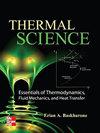新型水冷预混壁挂燃气锅炉热工性能的实验与仿真研究
IF 1.1
4区 工程技术
Q4 THERMODYNAMICS
引用次数: 0
摘要
本文创新性地提出并设计了一种壁挂式燃气锅炉。锅炉采用水冷预混燃烧和强化冷凝换热技术。燃烧器和冷凝式换热器均采用挤压铝板-翅片结构。对锅炉的流动、燃烧和换热特性进行了实验和数值模拟研究。分析了翅片结构、多余空气系数、热负荷和水冷却温度对锅炉热工性能的影响。结果表明,壁挂式燃气锅炉点火可靠,燃烧稳定,火焰分布均匀,污染物排放量低。受燃烧强度和内部烟气再循环的影响,当燃烧器板翅间隙为1.63 mm时,火焰最短,NOx排放量最低。在此工况下,可以在低过剩空气系数的情况下实现锅炉的超高效率和超低排放。当多余空气系数为1.3时,4 ~ 14 kW热负荷下NOx排放量小于30 mg/m3, 14 kW额定负荷下热效率可达102.8%。在实验范围内,NOx排放量随水冷却温度变化不大。在333 K温度下,仍有较好的NOx减排效果。本文章由计算机程序翻译,如有差异,请以英文原文为准。
Experiment and simulation studies on thermal performance of a novel water-cooling premixed wall-hung gas boiler
A wall-hung gas boiler was innovatively proposed and designed in this paper. Water-cooling premixed combustion and enhanced condensation heat exchange technology were adopted in the boiler. The extruded aluminum plate-fin structure was adopted in the burner and condensing heat exchanger. Experiment and numerical simulation studies were conducted on the flow, combustion, and heat exchange characteristics of the boiler. The effect of the fin structure, excess air coefficient, heat load, and water-cooling temperature on the thermal performance of the boiler was analyzed. The results showed that reliable ignition, stable combustion, uniform flame distribution, and low pollutant emissions can be achieved in the wall-hung gas boiler. Affected by burning intensity and internal flue gas recirculation, when the burner plate-fin gap was 1.63 mm, the flame was the shortest and the NOx emissions were the lowest. Under this fin condition, ultra-high efficiency and ultra-low emissions can be achieved in the boiler with a low excess air coefficient. When the excess air coefficient was 1.3, the NOx emissions were less than 30 mg/m3 at the heat load of 4-14 kW, and the thermal efficiency can reach up to 102.8% at the rated load of 14 kW. Within the scope of the experiment, the NOx emissions changed little with the water-cooling temperature. At the temperature of 333 K, there was still a great NOx emission reduction effect.
求助全文
通过发布文献求助,成功后即可免费获取论文全文。
去求助
来源期刊

Thermal Science
工程技术-热力学
CiteScore
2.70
自引率
29.40%
发文量
399
审稿时长
5 months
期刊介绍:
The main aims of Thermal Science
to publish papers giving results of the fundamental and applied research in different, but closely connected fields:
fluid mechanics (mainly turbulent flows), heat transfer, mass transfer, combustion and chemical processes
in single, and specifically in multi-phase and multi-component flows
in high-temperature chemically reacting flows
processes present in thermal engineering, energy generating or consuming equipment, process and chemical engineering equipment and devices, ecological engineering,
The important characteristic of the journal is the orientation to the fundamental results of the investigations of different physical and chemical processes, always jointly present in real conditions, and their mutual influence. To publish papers written by experts from different fields: mechanical engineering, chemical engineering, fluid dynamics, thermodynamics and related fields. To inform international scientific community about the recent, and most prominent fundamental results achieved in the South-East European region, and particularly in Serbia, and - vice versa - to inform the scientific community from South-East European Region about recent fundamental and applied scientific achievements in developed countries, serving as a basis for technology development. To achieve international standards of the published papers, by the engagement of experts from different countries in the International Advisory board.
 求助内容:
求助内容: 应助结果提醒方式:
应助结果提醒方式:


